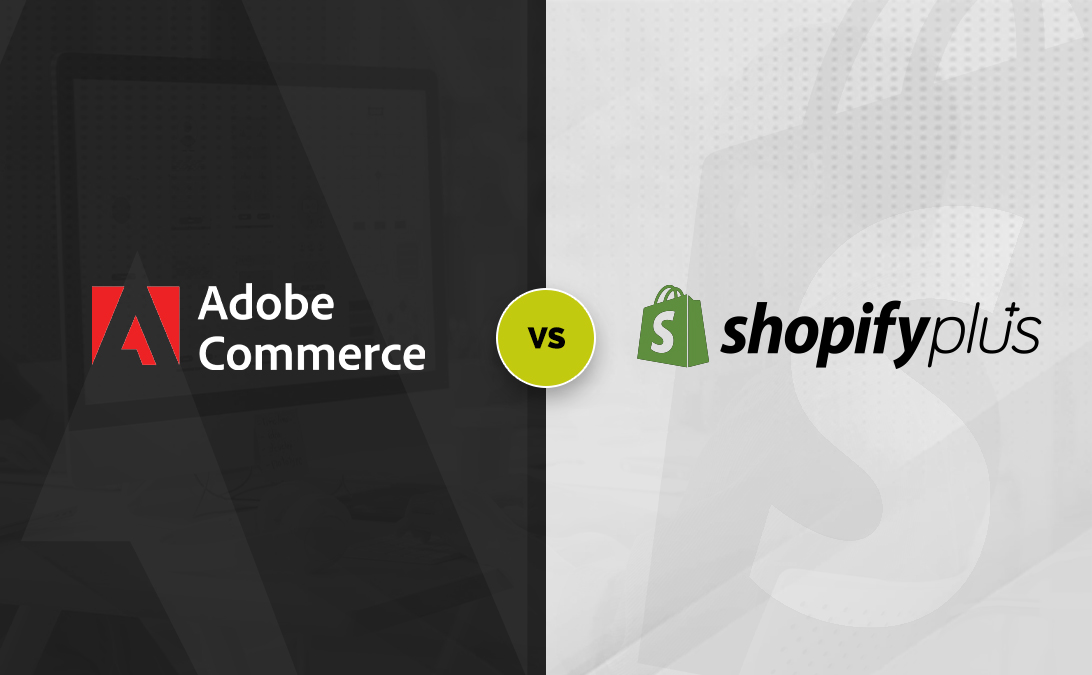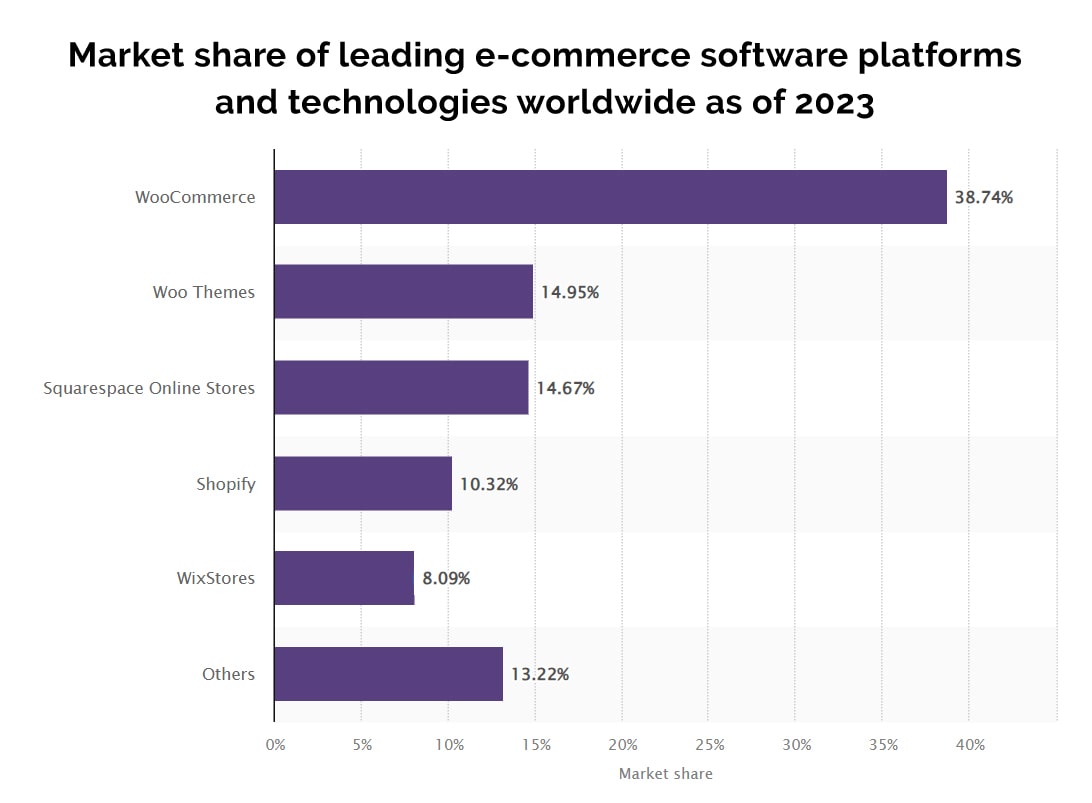
Adobe Commerce vs Shopify Plus- The Best eCommerce Platform in 2024
24 April 2024
In the race of digital technologies, selecting the right eCommerce platform can determine the success of your online store. Among various platforms, Adobe Commerce and Shopify Plus have emerged as trustworthy options for B2C, B2B & enterprise-level businesses.
Both platforms come with various out-of-the-box features and unique capabilities needed to build successful eCommerce businesses. Each has a distinct set of pros and cons when launching an online store.
This blog post dives into the Adobe Commerce vs Shopify Plus comparison to help you make well-informed decisions about your online business. Before we compare and contrast the details, let’s understand what these platforms are.
What is Adobe Commerce?
Powered by the Magento software, Adobe acquired Magento in 2018, becoming the parent company and forming its own product ‘Adobe Commerce’. A competitor of the free Magento open source platform.
Adobe Commerce is a trusted name for diverse businesses looking for an advanced eCommerce platform for their online store. The open source platform helps build seamless customer experiences, with powerful out of the box functionality such as advanced B2B features, AI powered live search and product recommendations and PWA studio.
Adobe Commerce allows businesses to navigate the complexities of the eCommerce landscape with greater confidence and agility. It provides diverse functionalities for companies trying their hands in eCommerce and established brands seeking advanced features and functionalities for scaling their business’ online presence.
Often, businesses choose Adobe Commerce for their B2B and B2C online stores because it has inbuilt flexible customisation possibilities, cloud infrastructure, stock management, smooth order processing, promotion and marketing tools, and more.
What is Shopify Plus?
At its core, Shopify Plus is the premier version of the well-established Shopify eCommerce platform. This version of Shopify is tailored to fulfill the precise needs of rapidly growing businesses, and well known for being easy to use. It provides greater offerings in terms of scalability, smooth management of the server infrastructure, and ease of maintenance.
The most experienced Shopify agency can tailor personalised online stores with simple-to-use and beautiful interface designs, driving sales and revenue. With Shopify Plus, businesses can focus on the core activities of refining their products and delivering a high customer experience.
As both platforms are adept at building digital stores, finding the better option can be pretty challenging. Let’s discuss the efficiency of the two platforms against standard eCommerce parameters to find the better option for you.
Adobe Commerce vs Shopify Plus – Detailed Comparison of Main eCommerce Parameters
1. Which one offers ease of building an online store?
When choosing the right eCommerce platform, the foremost thing that everyone should consider is the ease of building online stores. On the plus side, both platforms have simple interfaces, making building and launching online stores easier. However, when it comes to coding, Shopify Plus has the upper hand.
Shopify Plus is not open-source, meaning you cannot modify or change the existing code, unless with the help of a Shopify developer. It compensates for these issues by providing user-friendly functions like drag-and-drop builders, beautiful themes, and a large app store, hosting over 1000s of applications, which are easy to download and integrate, unlike the Adobe Commerce Cloud platform.
Adobe Commerce is open source, which means its code is available to everyone. This makes it easier for any Magento or Adobe Commerce development agency to tailor user-friendly stores that provide your customers with a hassle-free shopping experience.
2. Popularity Worldwide
When decoding the Shopify Plus vs Adobe Commerce comparison, you do not want to get stuck with a poor platform that is not renowned among users. Thankfully, both platforms are commercially popular and are used by global brands to sell a wide range of products and services.
Shopify holds 10.32% of the market share of leading eCommerce software platforms worldwide, this has grown rapidly over the last two years. This share demonstrates its popularity, and the infographic below highlights this.

Magento holds a market share of nearly 2.25% in the eCommerce market, and Adobe Commerce holds a small percentage of this. However, both brands are used by globally renowned companies, simple start ups, and growing SMEs.
For example, Land Rover, Helly Hansen, Ford, and various brands use Adobe Commerce. On the other hand, large brands like Gymshark, Boden, Tesla, Lindt, and others prefer Shopify. So, when weighing up the popularity of Shopify Plus vs Adobe Commerce, Shopify wins.
3. Total Cost of Ownership
It is well known among developers of eCommerce platforms that stores built with Adobe Commerce, whether that’s Cloud or On-Premise are usually costlier than those on the Shopify Plus platform. However, the cost largely depends upon your precise requirements. Shopify stores can also be costly based on the level of personalisation and development time.
The three main factors that influence the precise cost of any eCommerce business are:
- Monthly Plans: Shopify Plus and Adobe Commerce are both licensed platforms, with the monthly fee primarily based on total GMV (Gross Merchandising Value) and AOV (Average Order Value). Shopify’s monthly cost starts from $2,500. For Commerce, the cost for the license fee can differ depending on whether you choose the Cloud version or On-Premise (alternative third-party hosting). For Cloud the license is paid monthly, with On-Premise, the cost of the license is usually paid up front.
- Themes Pricing & Personalisation: Shopify offers an abundance of official themes. You can choose from 80 Shopify themes, 9 of which are totally free to use. A Shopify developer can tailor these themes to create bespoke solutions for your business. Magento’s native Luma theme is free and easily customisable. Magento has such a large partner ecosystem, and for merchants there are 100’s of themes available to choose from available on the Magento marketplace, or third-party sites such as ThemeForest. If we were to compare themes based on look and feel, then Shopify wins.
- Third-party integrations: Both platforms offer out-of-the box features
- Support & Maintenance: It’s fair to say that Magento websites require more developer support when it comes to applying security patches, version upgrades, installing third-party modules/apps and maintaining server infrastructures, because of the nature of the code being more complex. Shopify requires less ‘developer’ support for upgrades, because the platform updates automatically, however, support and maintenance is still required in terms of prepare digital roadmaps for online growth.
4. Marketing, Sales and SEO Features
The three main strategies that decide the fate of your eCommerce businesses are Marketing, Sales, and Search Engine Optimisation. An effective strategy makes reaching out to the targeted customers and building brand values easier. So, the Shopify Plus vs Adobe Commerce debate is again important and inspecting the features offered by these platforms is vital.
- Marketing Features: Shopify marketing features let you directly broadcast ads on popular social media platforms like Facebook and Instagram and execute email marketing campaigns. Adobe Commerce can also leverage social media platforms by integrating third-party extensions into the digital store.
- Sales Features: Adobe Commerce and Shopify Plus provide industry-standard sales tools, making it easier to boost business revenue. The difference is that basic Shopify has in-built tools, whereas installing Adobe Commerce extensions is necessary to access sales tools.
- SEO Features: Both Adobe Commerce and Shopify platforms allow you to alter the meta descriptions and tags for good SEO visibility. You can also add different alt tags, replace URLs, and play with other factors for maximum search engine optimisation. However, it is important to note that Adobe Commerce has built-in SEO capabilities. On the other hand, the Shopify platform requires web developers to use SEO add-ons from the Shopify app store.
5. Pros & Cons
Let’s start with the pros…
Shopify Plus’s greatest strength is its simplicity to manage your store without relying on technical expertise. The platform is extremely user-friendly and provides beautifully designed websites that can make you stand out from your competitors. With over 1000 apps available you can easily scale up your eCommerce store enhancing its features and functionality.
Adobe Commerce as we mentioned previously is an open-source platform, therefore its major strength is the scalability and flexibility the platform offers. There is also a marketplace with a vast range of third-party modules to integrate with and build upon the out-of-the-box features, to enhance website usability. To date, Adobe Commerce is still the best B2B eCommerce platform in the market, Shopify is expanding its B2B offering but depending on the scale of the B2B needs of a business, Commerce wins.
As for the cons, Shopify Plus applies transaction fees for payments used by third-party providers (e.g. Stripe, Opayo), and ideally want you to use their own payment gateway. Shopify is not ideal for merchants selling products with over 1000 variations or complex product offerings.
Commerce is developer focused, therefore costly when it comes to maintenance and support. Without an in-house development team or Magento agency support, a merchant with little technical knowledge would not see as much growth of their online store, compared to Shopify.
Conclusion: Magento or Shopify
The Adobe Commerce vs Shopify Plus battle in the world of eCommerce will continue. Both are well-suited for a range of solutions, and the right choice is dependent on your business plans and expectations. At chilliapple, an established eCommerce agency, we design and build in both platforms dependent on our clients’ needs.
We generally suggest companies hire our Shopify developers when looking for a website that is easy to manage, with relatively straightforward eCommerce requirements. If a merchant is looking for a complex website to meet niche business requirements then Shopify might not be the right fit.
However, the eCommerce platform Adobe Commerce proves better for large-scale B2C and B2B eCommerce stores and our Adobe Commerce experts can tailor a solution to suit your online store.
Ultimately, the choice between Adobe Commerce and Shopify Plus depends on the unique needs and priorities of your business. At chilliapple, we understand that no two businesses are alike, which is why we offer expertise in both platforms to help our clients make informed decisions.
Whether you’re a B2B enterprise seeking unparalleled customisation and scalability or a B2C startup looking for simplicity and agility, our team of experienced developers is here to guide you every step of the way. With our proven track record in Adobe Commerce and Shopify Plus development, you can trust chilliapple to deliver ecommerce solutions that drive results and propel your business forward.
Contact us today to learn more about how we can help you harness the power of Adobe Commerce, Shopify Plus, or both, to unlock your full ecommerce potential.





